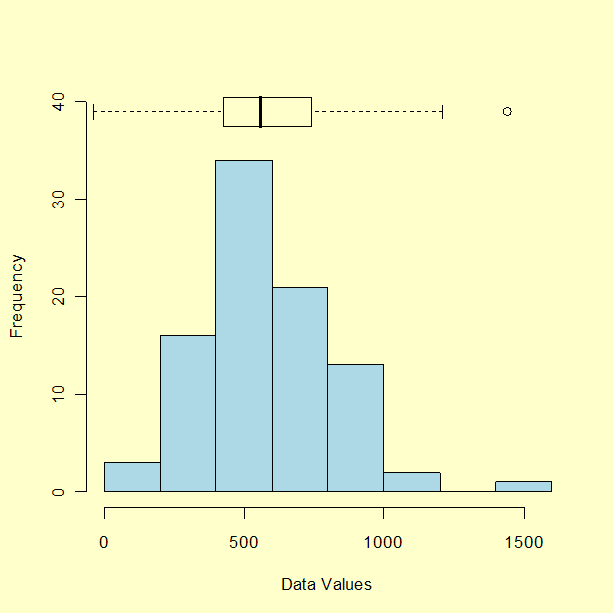7.1. Introduction
7.1.6. |
What are outliers in the data? |
- Examination of the overall shape of the graphed data for
important features, including symmetry and departures from
assumptions. The chapter on
Exploratory Data
Analysis (EDA) discusses assumptions and summarization
of data in detail.
- Examination of the data for unusual observations that are far removed from the mass of data. These points are often referred to as outliers. Two graphical techniques for identifying outliers, scatter plots and box plots, along with an analytic procedure for detecting outliers when the distribution is normal (Grubbs' Test), are also discussed in detail in the EDA chapter.
- lower inner fence: Q1 - 1.5*IQ
- upper inner fence: Q3 + 1.5*IQ
- lower outer fence: Q1 - 3*IQ
- upper outer fence: Q3 + 3*IQ
30, 171, 184, 201, 212, 250, 265, 270, 272, 289, 305, 306, 322, 322, 336, 346, 351, 370, 390, 404, 409, 411, 436, 437, 439, 441, 444, 448, 451, 453, 470, 480, 482, 487, 494, 495, 499, 503, 514, 521, 522, 527, 548, 550, 559, 560, 570, 572, 574, 578, 585, 592, 592, 607, 616, 618, 621, 629, 637, 638, 640, 656, 668, 707, 709, 719, 737, 739, 752, 758, 766, 792, 792, 794, 802, 818, 830, 832, 843, 858, 860, 869, 918, 925, 953, 991, 1000, 1005, 1068, 1441
The above data is available as a text file.
The computations are as follows:
- Median = (n+1)/2 largest data point = the average of the 45th and 46th ordered points = (559 + 560)/2 = 559.5
- Lower quartile = .25(N+1)th ordered point = 22.75th ordered point = 411 + .75(436-411) = 429.75
- Upper quartile = .75(N+1)th ordered point = 68.25th ordered point = 739 +.25(752-739) = 742.25
- Interquartile range = 742.25 - 429.75 = 312.5
- Lower inner fence = 429.75 - 1.5 (312.5) = -39.0
- Upper inner fence = 742.25 + 1.5 (312.5) = 1211.0
- Lower outer fence = 429.75 - 3.0 (312.5) = -507.75
- Upper outer fence = 742.25 + 3.0 (312.5) = 1679.75
From an examination of the fence points and the data, one point (1441) exceeds the upper inner fence and stands out as a mild outlier; there are no extreme outliers.


